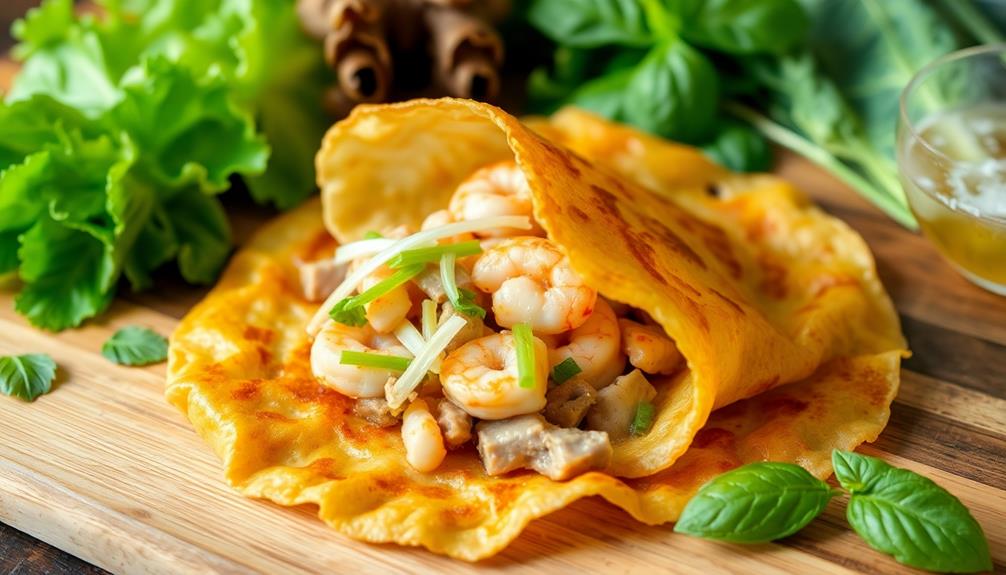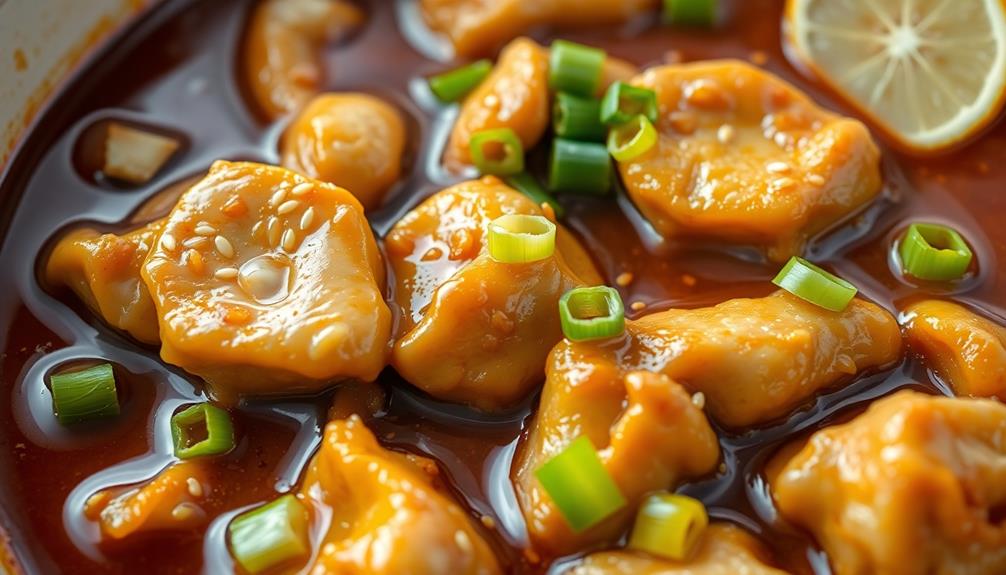Have you ever heard of Banh Xeo, the mouthwatering Vietnamese crispy pancake? This sizzling delight hails from the lush Mekong Delta, where skilled cooks have perfected the recipe for generations. With a delicate, lacy exterior and savory fillings like pork, shrimp, and crunchy bean sprouts, each bite offers a symphony of textures and flavors. Served with fresh herbs and zesty dipping sauce, Banh Xeo is a true celebration of Vietnamese culinary artistry. Whether you're enjoying it at a local market or trying your hand at making it at home, this versatile dish is sure to tantalize your taste buds and leave you craving more.
Key Takeaways
- Banh Xeo is a popular Vietnamese crispy pancake originating from the Mekong Delta region, known for its sizzling sound during cooking.
- The pancake features a lacy, golden-brown exterior with savory fillings like pork, shrimp, and bean sprouts, providing a satisfying contrast of textures.
- Banh Xeo is a significant part of Vietnamese culinary heritage, representing the country's communal eating culture and adaptability in international cuisine.
- The key ingredients for Banh Xeo include a batter made with rice flour, coconut milk, and water, as well as various fresh fillings.
- Proper cooking techniques, such as using a hot, well-seasoned pan and working in small batches, are crucial to achieve the desired crispy texture.
History
Banh xeo, the crispy Vietnamese pancake, has a rich history dating back centuries. This beloved dish originated in the Mekong Delta region, where the warm, humid climate and abundant ingredients created the perfect conditions for its creation.
The name "banh xeo" translates to "sizzling cake," a nod to the distinctive sound the batter makes when it hits the hot pan.
Over time, banh xeo has evolved, with different regions developing their own unique variations. In the north, you might find a thicker, more filling pancake, while the southern version is often thinner and crispier.
But no matter where you go, the core ingredients remain the same – a rice flour batter, fresh herbs, and a variety of fillings like shrimp, pork, and bean sprouts.
Preparing banh xeo is an art form, requiring skill and precision to achieve the perfect golden-brown exterior and tender, flavorful interior.
It's a beloved part of Vietnamese culinary heritage, and one that continues to delight and inspire food lovers around the world.
Recipe
Banh Xeo, or Vietnamese Crispy Pancakes, are a beloved street food in Vietnam. These savory crepes are made with a rice flour batter and packed with a flavorful filling of sautéed pork, shrimp, and bean sprouts. The result is a crispy, golden-brown shell that gives way to a delightful blend of textures and tastes. Many street vendors and families have their own variations of Banh Xeo, but the traditional method of making xoi involves using a special non-stick skillet and a hot fire to achieve the perfect crispiness. These savory pancakes are often served with a side of fresh lettuce and herbs, as well as a dipping sauce made with fish sauce, lime juice, and chilies. The combination of flavors and textures makes Banh Xeo a popular and satisfying dish enjoyed by many in Vietnam.
The key to achieving the perfect Banh Xeo lies in the batter and the technique. The rice flour batter must be thin enough to create a delicate, lacy crepe, yet thick enough to hold the filling ingredients. The cooking process also requires a deft hand, as the pancakes must be swiftly folded and served hot to maintain their irresistible crispiness.
Ingredients:
- 1 cup rice flour
- 1/2 cup all-purpose flour
- 1 cup coconut milk
- 1 cup water
- 1 teaspoon salt
- 1 pound boneless pork, thinly sliced
- 1 pound shrimp, peeled and deveined
- 2 cups bean sprouts
- 1 onion, thinly sliced
- 2 tablespoons vegetable oil
Cooking Instructions:
In a large bowl, whisk together the rice flour, all-purpose flour, coconut milk, water, and salt until the batter is smooth and free of lumps.
Heat a large non-stick skillet over medium-high heat and add the vegetable oil. Pour in a thin layer of the batter, swirling the pan to coat the bottom evenly. Quickly add the pork, shrimp, bean sprouts, and onion to one half of the crepe.
Fold the other half over the filling and cook until the crepe is golden and crispy, about 2-3 minutes per side. Serve the Banh Xeo warm, with accompanying dipping sauces and fresh herbs.
When cooking Banh Xeo, it's important to work quickly and in small batches to maintain the perfect texture. The batter should be thin enough to create a lacy, delicate crepe, but not so thin that it becomes difficult to handle.
Additionally, be sure to use a hot, well-seasoned pan to achieve the desired crispiness on the exterior of the pancake.
Cooking Steps
Let's get cookin'!
First, you'll whip up the batter by mixing flour and water.
Next, you'll toss in some bean sprouts, shrimp, and pork.
Finally, fold that crispy pancake over the yummy fillings and serve it up right away with a tasty dipping sauce.
Mmm, can't you just smell the deliciousness?
Step 1. Make Batter by Mixing Flour and Water
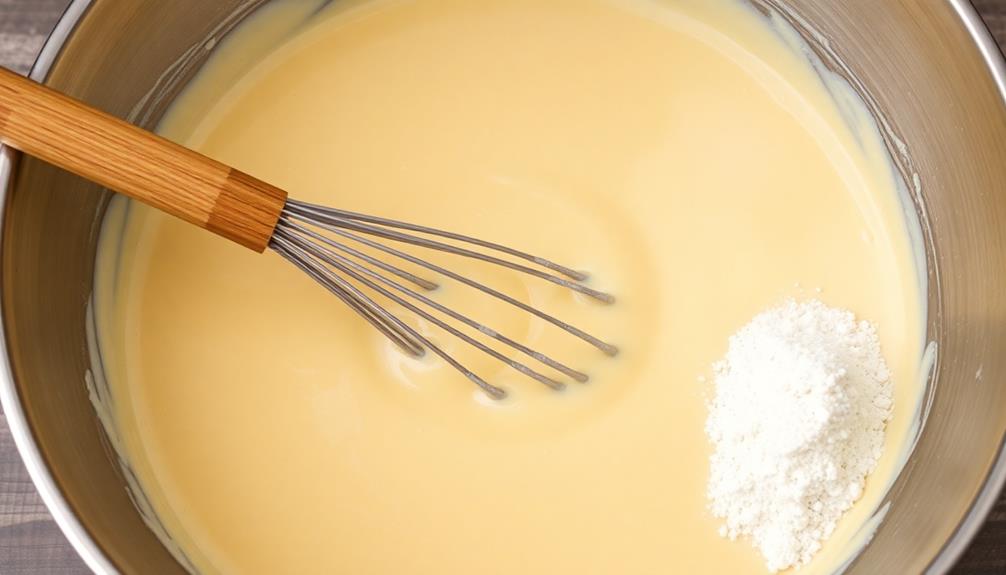
To make the batter, you'll need to combine the flour and water. In a large bowl, add the all-purpose flour and gradually pour in the water, stirring constantly. You'll want to mix the ingredients until the batter is smooth and free of lumps.
Don't be afraid to get your hands in there to really work the mixture! The batter should have a pourable, pancake-like consistency. If it seems too thick, simply add a bit more water. Once you've got the perfect texture, let the batter rest for about 30 minutes. This will help the flour fully hydrate and create an extra crispy pancake.
Now that your batter is ready, it's time to start cooking! Heat up a large skillet or non-stick pan over medium-high heat. When the pan is nice and hot, pour in about 1/4 cup of the batter, swirling it around to create a thin, even layer.
Let the pancake sizzle until the edges are golden brown and crispy, then flip and cook the other side. Repeat with the remaining batter. Yum!
Step 2. Add Bean Sprouts
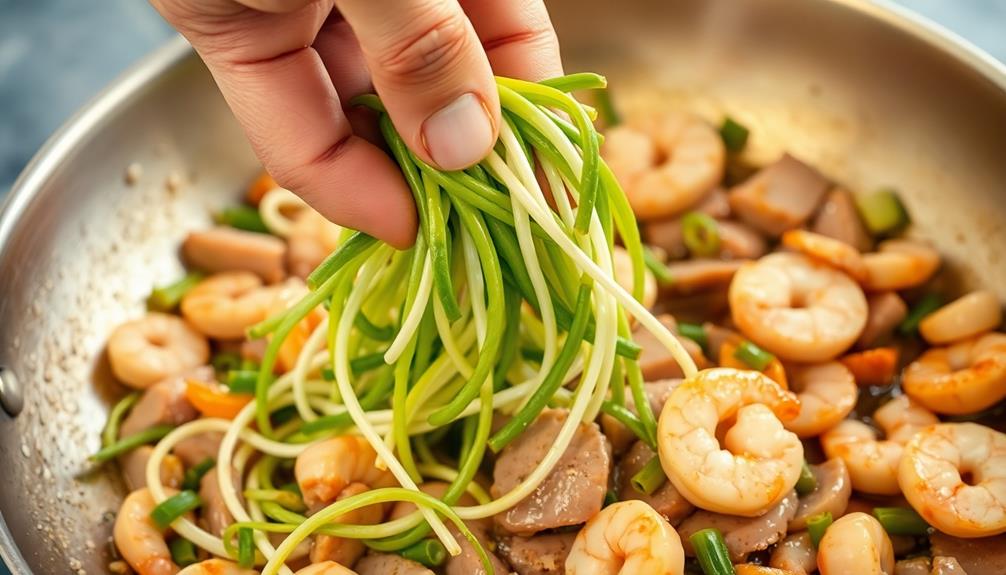
After you've cooked up those crispy pancakes, it's time to add the bean sprouts.
Grab a handful of the fresh, crunchy bean sprouts and carefully place them on top of the sizzling pancake.
Watch as they start to wilt and sizzle, absorbing all the delicious flavors.
The bean sprouts add a wonderful crunch and a subtly sweet taste that complements the savory pancake perfectly, much like how bread pudding transforms stale bread into a comforting dessert.
As the bean sprouts cook, they'll release a mouthwatering aroma that'll have your taste buds tingling with anticipation.
Give the pancake a gentle shake to help the bean sprouts nestle into the nooks and crannies.
This is where the magic happens – the bean sprouts will crisp up, creating a delightful textural contrast against the soft, tender pancake.
Get ready to dig in and savor every bite of this flavorful and satisfying dish!
Step 3. Add Shrimp and Pork

Next, add the shrimp and pork to the sizzling pancake. Toss them in with the bean sprouts and let everything sizzle and pop!
The juicy shrimp and savory pork will add tons of flavor to your crispy banh xeo. Stir and flip the pancake so the ingredients cook evenly. You'll love the contrast of the crunchy edges and the tender fillings.
The shrimp and pork should turn a lovely golden-brown as they cook through. Inhale the mouthwatering aroma – garlic, ginger, and a hint of spice!
Scoop up a bite, making sure to get a little of everything. The textures and flavors will dance on your tongue. Mmm, so satisfying!
Keep cooking and flipping until the pancake is perfectly crisp. Now it's ready to enjoy.
Stuff the banh xeo into lettuce leaves, add some fresh herbs, and dig in. Your taste buds are in for a real treat!
Step 4. Fold Pancake Over Fillings

Once the shrimp and pork have cooked through, it's time to fold the pancake over the fillings.
Grab the edges of the crispy, golden-brown pancake and gently fold it in half over the sizzling shrimp and pork. The aroma of the savory filling will make your mouth water!
Fold the pancake again to create a neat half-moon shape, trapping all the delicious ingredients inside. Isn't it satisfying to see the pancake envelope the fillings?
Now, carefully transfer the folded pancake to a plate, making sure not to tear the delicate, crunchy shell. You'll want to work quickly to keep the pancake warm and the fillings hot.
With the pancake neatly folded, you're ready to serve this Vietnamese delight.
Get ready to bite into the perfect balance of textures and flavors – the crispy exterior, the tender shrimp and pork, and the fresh herbs. Mmm, it's going to be a tasty treat!
Step 5. Serve Immediately With Dipping Sauce
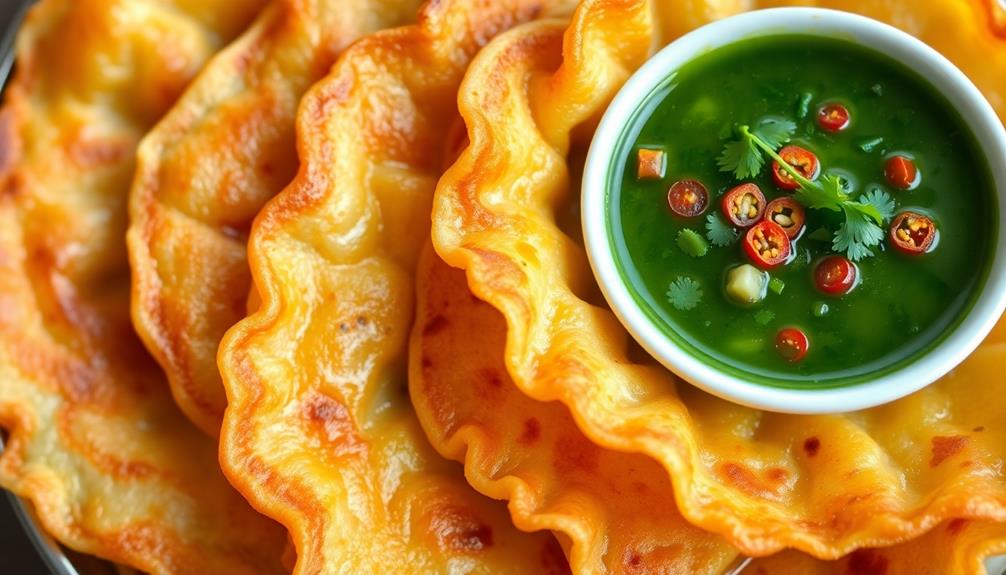
Serve the folded banh xeo immediately, as its crispness is best enjoyed fresh from the pan.
Carefully transfer the golden, sizzling pancake to a plate, being careful not to lose any of the tasty fillings. The aromatic steam wafting up is sure to get your mouth watering!
Accompany the banh xeo with a savory dipping sauce on the side. This sauce is the perfect complement, adding a burst of tangy, sweet, and spicy flavors to each crunchy bite.
Dip the crisp edges of the pancake into the sauce, letting the flavors mingle together. The slight char on the outside of the banh xeo provides a delightful contrast to the soft, tender interior.
Don't be afraid to get your hands a little messy – the fun is in picking up the banh xeo and enjoying it in all its glory.
Savor each flavorful mouthful, relishing the harmony of textures and tastes. This Vietnamese specialty is sure to become a new favorite!
Final Thoughts
Ultimately, banh xeo is a delightful Vietnamese dish that offers a unique flavor and texture experience. The crispy, golden-brown pancake is a real showstopper, with its lacy edges and savory fillings.
Imagine biting into that satisfying crunch, only to be met with the vibrant, juicy flavors of the pork, shrimp, and crunchy bean sprouts. It's a party in your mouth!
What makes banh xeo so special is the way the ingredients work together. The batter's crispiness provides the perfect contrast to the tender fillings, while the dipping sauce adds a tangy, sweet, and slightly spicy kick.
It's a perfectly balanced dish that will have you reaching for more.
Frequently Asked Questions
Is Banh Xeo Gluten-Free?
Yes, banh xeo is typically gluten-free. It's made with rice flour, which doesn't contain gluten, and the fillings are usually gluten-free ingredients like shrimp, pork, and vegetables. So, you can enjoy this crispy Vietnamese pancake if you have a gluten intolerance.
What Are the Best Accompaniments for Banh Xeo?
The best accompaniments for this savory pancake are typically fresh herbs like mint, basil, and perilla, along with a tangy dipping sauce made with fish sauce, lime juice, and chili. You can also add crisp lettuce leaves to wrap the pancake.
Can I Make Banh Xeo Ahead of Time?
You can make banh xeo ahead of time, but it's best to assemble and fry the pancake right before serving. The crispy exterior won't hold up as well if you make it too far in advance.
Is Banh Xeo Suitable for Vegetarians or Vegans?
Banh xeo can be a suitable dish for vegetarians and vegans if you make it without the traditional shrimp or pork fillings. You can substitute the protein with tofu, mushrooms, or a variety of fresh vegetables to create a delicious meat-free version.
How Can I Make Banh Xeo Crispy?
To make your crispy pancake, use a hot, well-oiled pan and pour in a thin layer of batter. Cook until the edges are golden and the center is set, then flip and cook the other side.
